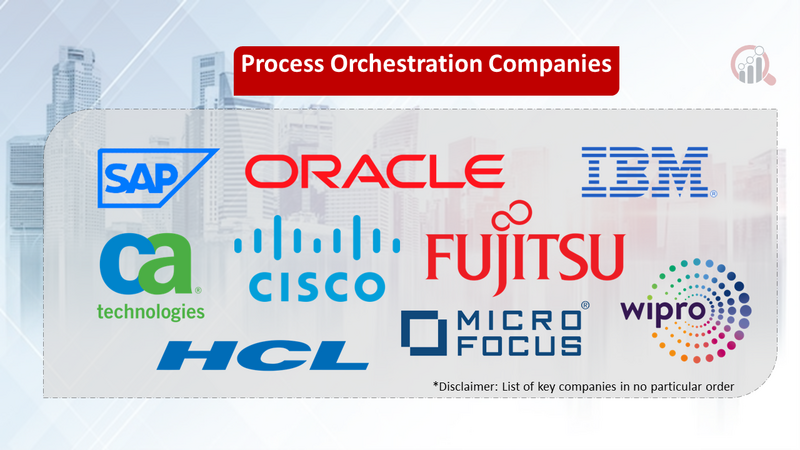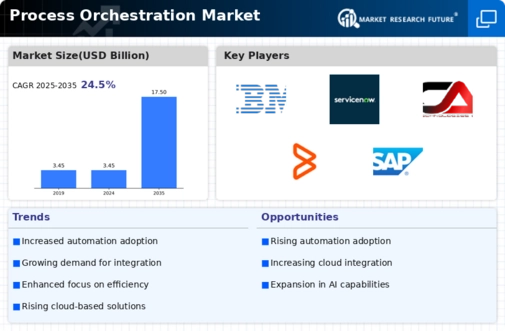Top Industry Leaders in the Process Orchestration Market

Competitive Landscape of the Enterprise Process Orchestration Market: A Deep Dive
The enterprise process orchestration (EPO) market is experiencing explosive growth, fueled by the need for businesses to streamline complex workflows, optimize operations, and embrace digital transformation. This burgeoning landscape boasts a diverse range of players, each vying for market share through distinct strategies and a focus on specific industry verticals. Understanding this dynamic arena is crucial for established companies and aspiring entrants alike.
Key Players:
-
SAP SE (Germany)
-
IBM Corporation (US)
-
Oracle Corporation (US)
-
CA Technologies (US)
-
ServiceNow Inc (US)
-
Cisco Systems Inc (US)
-
BMC Software Inc (US)
-
Fujitsu Ltd (Japan)
-
OpenText Corporation (Canada)
-
Newgen Software Technologies Limited (US)
-
Software AG (Germany)
-
HCL Technologies Limited (India)
-
Wipro (India)
-
Micro Focus International PLC (UK)
Strategies for Success:
-
Product Innovation: Continuous development of AI-powered features, automation capabilities, and integration with other technologies like RPA is crucial for differentiation and attracting customers.
-
Cloud Adoption: Offering cloud-based and hybrid deployment options cater to modern infrastructure trends and increase scalability.
-
Partnerships and Acquisitions: Collaborating with complementary technology providers and acquiring niche players can expand offerings and reach new markets.
-
Vertical Focus: Tailoring solutions to specific industry needs through pre-built templates and industry-specific functionalities creates a competitive edge.
Factors for Market Share Analysis:
-
Revenue and Market Share: Analyzing the financial performance of key players provides a snapshot of their market dominance.
-
Customer Base and Industry Focus: Understanding the size and composition of a company's customer base, along with their industry focus, reveals their market reach and target segments.
-
Product Features and Functionality: Assessing the breadth and depth of features, ease of use, and integration capabilities differentiates offerings.
-
Innovation and Development Roadmap: Analyzing a company's commitment to R&D and future product plans indicates their potential for growth and market leadership.
New and Emerging Companies:
The EPO market continuously welcomes new entrants, often specializing in niche areas. Notable examples include:
-
Unqork: Focuses on low-code/no-code platforms for citizen developers to build simple automations.
-
ProcessMaker: Offers open-source, community-driven EPO solutions with a focus on agility and customization.
-
Mocana: Provides IoT-specific process orchestration solutions for managing connected devices and data streams.
Current Company Investment Trends:
-
AI/ML Integration: Companies are heavily investing in AI and machine learning capabilities to enhance automation, decision-making, and process optimization.
-
Hyper-automation: The focus is shifting towards interconnected automation platforms that orchestrate multiple processes across the enterprise.
-
Low-code/No-code Development: Tools and platforms empowering citizen developers to build and manage simple automations are gaining traction.
-
Cloud-based Solutions: The transition towards cloud-based and hybrid EPO solutions is accelerating, driven by scalability and flexibility benefits.
Latest Company Updates:
-
Dec 12, 2023: UiPath, a leading RPA provider, announced the acquisition of Cloud Elements, a cloud-based integration platform. This move strengthens UiPath's process orchestration capabilities.
-
Jan 3, 2024: Pegasystems, a business process management (BPM) software provider, unveiled its new process orchestration solution, Pega Infinity Orchestrator. Pega aims to simplify complex workflows with a focus on business users.
-
Jan 9, 2024: Celonis, a process mining and optimization company, announced a partnership with Microsoft Azure to offer its process orchestration platform on the cloud. This collaboration expands Celonis' reach to a broader audience.









